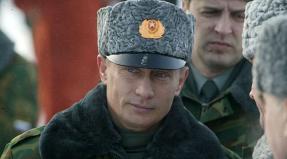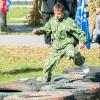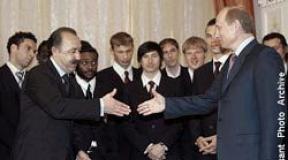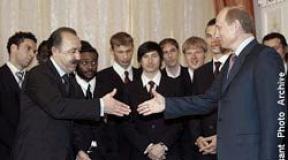Military doctrine of the Russian Federation essence. How the Military Doctrine of the Russian Federation was created, its concept and features

The concept of "Military doctrine" is most often understood as a series of prescriptions that determine how the military forces and means of a particular state will be used to achieve political goals, various global military tasks and large-scale military development. The content of the Military Doctrine touches upon all spheres and aspects that relate to the preparation of the state for a probable war or repulsing a possible attack.
Each state has such a document and determines the state's military policy in relation to other countries. The doctrine can be adopted by both a separate state and a union state formation. In the latter case, the text of the document is approved in accordance with the military policy followed by the allied states. Most often, in this case, it is the strongest state in the union bloc.
The military doctrine of the Russian Federation is approved by the President of the Russian Federation. It is defensive in nature, establishes involvement in various military bases to ensure the country's military security.
Compared to the US Military Doctrine, which provides for a global strike anywhere in the world, the Russian one provides for the use of armed forces only as a last resort. At the same time, maintaining the troops in a state of high combat readiness, as well as equipping them with the latest weapons and military equipment, are among the priorities of the Russian doctrine. Judging by the political situation in the world arena for 2010-2014, it is safe to say that every year the need for a new declaration on military policy has grown.
In 2014, the President of the Russian Federation approved a new Military Doctrine of the Russian Federation. The president had to approve the updated text due to the change in the political situation in the world. In the document, the President noted that NATO member countries are geopolitical opponents of Russia. In addition, the unstable situation in Ukraine and the Far East also required some changes. With the adoption of the new document in 2014, the previous version of the text, which was approved by the President of Russia in 2010, was canceled.

Approval of the Military Doctrine of the Russian Federation
The new version was approved by the Security Council of the Russian Federation in December 2014. After that, the doctrine was sent to the president for signature. The updated Military Doctrine, which is the most important defense state element, appeared on December 26, 2014.
Although the main text remained practically unchanged, various additions that were made there significantly changed the essence of the document.
A Brief History of the Emergence of the Military Doctrine in Modern Russia
The first Military Doctrine emerged in modern Russia back in 1993. Prior to that, Russia used the documents of the USSR, which were adopted in 1987. The emergence of a new Military Doctrine was a forced measure, since the political situation in the world has long demanded the creation of such an integral document. In the early 90s, most developed countries had such normative documentation. Usually it covered a wide range of military-political issues, and also determined the algorithm of the army's actions as a result of an enemy attack. The following Military Doctrines were adopted in 2000, 2010 and 2014.
Since the new National Security Strategy was released in 2015, the Russian Military Doctrine was also supplemented with a number of changes in 2016.

If we take the United States as an example, then they have long had a National Defense Strategy, which is an analogue of the Russian Military Doctrine. The US strategy is represented by a collection of documents that addresses a wide range of issues related to military and national security. By the way, it was in the United States that the tradition was laid, according to which the military doctrine of the country (or its analogues, which may have other names) was approved by the president, because in a number of countries it is the president who is the Commander-in-Chief of the Armed Forces.
In addition, the United States has developed an effective tool for making changes and additions to it, which is often a necessity of extreme importance, since the political situation in the world is very unstable. This tool is the annual report of the Minister of Defense, which he makes for the following organizations:
- For the US Congress;
- For the Chairman of the United States Chiefs of Staff;
- For the American White Paper.
The first Russian Military Doctrine dates back to 1993. It was in this year that the President of Russia for the first time approved a specific document that dealt with the further military policy of Russia in the world arena and in the event of a surprise attack by the enemy. This document was named "Basic Provisions of the Military Doctrine of the Russian Federation". Before the appearance of this document, the public was warned through various media. At the same time, the military academies of Russia were discussing the norms that were planned to be enshrined in the texts of the document.

The main issues to be solved by the Military Doctrine of Russia
The modern version of the military document is able to answer a number of the following questions:
- Which country is most likely to become an adversary, and what is the approximate scenario for a possible war;
- What are the nuances of the proposed war;
- What global goals and objectives should the state pursue in the course of the war;
- How can a possible military clash be prevented so that it does not "spill over" into a large-scale war;
- Creation of a military organization that will have to take over the leadership after the onset of hostilities on a national scale;
- How and with what means the war will be fought;
- How the state will conduct full-scale hostilities;
- Algorithm for preparing for war and algorithms for the use of force in the event of armed conflicts.
In general, the Military Doctrine of the Russian Federation has normative, informational and organizational functions that determine the algorithm of actions to prepare the state for war, as well as defense and attack, from the point of view of the use of military force.

Basic principles and concepts of the Military Doctrine of Russia
Since most of the major world powers, which can become possible opponents of Russia in the event of a war, have nuclear weapons, any military conflict should, if possible, be resolved without the use of strategic nuclear weapons. The use of nuclear weapons by one of the warring parties will cause a response, which can lead to a global world catastrophe. That is why the Russian government is focusing on the use of non-nuclear weapons. Much attention is paid to new development of weapons that can become a powerful deterrent for potential adversaries in the near future.
The updated document introduced a new concept of "non-nuclear deterrent system". This concept is a set of various measures that are comprehensively aimed at the development, armament and use of powerful non-nuclear weapons against a potential enemy of the Russian Federation.
Having studied the Military Doctrine of the Russian Federation, the following directions in military organizational development and military policy can be distinguished, which are arranged in descending order:
- Containment of the enemy with nuclear weapons. This paragraph provides for the delivery of nuclear strikes against the enemy after the first or as a retaliatory counter strike. This strike should be carried out by railway missile systems, as well as strategic submarines. In the event of a nuclear retaliatory strike, the submarines must deliver a general retaliatory strike;
- Defense by aerospace forces, which includes the use of high-precision non-nuclear weapons. These strikes should be applied to the accumulation of forces of the US army and their possible allies;
- Large-scale military conflicts with NATO armies, which can occur both within various borders with Russia and on the territory of the CIS countries;
- Solution of the regional Far Eastern conflict;
- Territorial conflicts with Japan;
- Reflection of various types of missile strikes that can be directed at Moscow. This issue should be effectively dealt with by the missile defense system, which is located in the Moscow region;
- Various local conflicts and peacekeeping operations. They can be both on the territory of Russia and on the entire territory of the post-Soviet space;
- Operations aimed at countering piracy in the Indian Ocean, as well as various military operations in the Arctic region.

The main content of the Military Doctrine of the Russian Federation
Although Russian doctrine has been substantially updated, the classification of wars and military conflicts has not changed at all. Many military experts continue to complain that the updated documentation does not have a clear definition of the concept of "war". This can lead to the fact that any conflicts can be interpreted as a military invasion, even if it is a provocation.
Some military experts in 2016 suggested including their own definition of "war". In their definition, war is the highest form of conflict resolution among states, social, religious or ethnic groups, which takes place with the use of armed violence of high intensity. The main goal of such an event is the full achievement of certain goals of one of the parties to the conflict.
Classification of wars on various grounds
Since in modern conditions it is impossible to give a complete definition of the term "war" on the basis of several criteria, the system for defining wars is rather complicated. For example, you can classify a war according to the technological level of the opposing sides:
- Technologically underdeveloped states. This type of war is dangerous only to its direct participants, since the weapons of the parties, as a rule, are small arms. As an example, one can cite constant gatherings in Latin American countries or Africa;
- Highly developed states. The last example of this type was the Second World War. In modern conditions, the war of high-tech states can lead to the destruction of all mankind on the planet;
- Between underdeveloped and high-tech states. As an example, we can cite the war between the United States and Iraq, which lasted from 2003 to 2011.

Often, wars are classified according to the use of strategy to achieve their goals:
- The simplest is the use of a strategy for the direct physical destruction of the enemy. As a rule, this strategy is used by underdeveloped states;
- The most perfect is when an indirect strategy is used. This could be the simplest economic blockade. In a more complex case, this type of war consists in supporting the opposition forces in the state, often using indirect or direct support of the troops;
- Mixed media, which includes a combination of the first two methods.
In terms of the scale of the war, there are the following types:
- Local. They are conducted only within the adversary states. Often wars of this type develop into larger-scale ones;
- Regional. These wars are waged by several states in one of the regions. Unlike local wars, the goal is more significant here;
- Large-scale. The most serious type of war. As a rule, not ordinary states, but whole coalitions of states. The last large-scale war that took place in the world was World War II. Everyone is well aware of the terrible devastation caused by conflicts of this type.
Also, wars can be divided according to the type of weapons used in them:
- The most dangerous can be a nuclear war. Since the largest world powers have nuclear weapons, then when a conflict breaks out between them, nuclear weapons may well be used. This can destroy all life on earth, so no one wants to start it;
- With the use of weapons of mass destruction. This group includes both nuclear and chemical weapons;
- Using conventional weapons. Most wars today are of this type;
- In theory, wars can occur using revolutionary weapons.
In accordance with the norms of international law, wars are:
- "Fair", that is, when they are conducted in compliance with the norms of international law. As a rule, such wars are waged to protect the national interests and independence of the country;
- "Unjust" wars. This is the so-called "aggression", when all norms of international law are blatantly violated or ignored.
War can take place between the following participants:
- Among states;
- Between the coalition and the state;
- Among coalitions;
- Between different ethnic or social groups in the same state. Such a war is called a civil war.

Sources of external military danger
According to the new edition, the sources of external and internal military danger are clearly defined. Depending on the military-political situation, it is possible to determine when Russia should prepare for war.
The following circumstances are understood as sources of external danger:
- The main source of external danger is considered to be the global strengthening of the NATO bloc and the deployment of its troops near the eastern Russian borders. Judging by the current state of the European NATO forces, only American troops should be feared. Despite the fact that the "yellow" Russian press is constantly "trumpeting" about the danger posed by European NATO troops, in fact, things are not very rosy there;
- Aggravation of the political situation in the country. This item may include incitement of interethnic or class enmity at the expense of foreign states;
- Also, the danger can be posed by various military groups or bandit formations, which are often sponsored by a potential adversary.
In addition to the above, sources of external danger include the militarization of outer space and the deployment of antimissile defense near the Russian borders. Due to the fact that in recent years the United States has been actively using the system of blackmail with strategic high-precision missiles, this item also refers to external military threats.
In addition to indirect sources of external danger, there may also be direct military threats to Russia. Such threats are understood as:
- Territorial claims against both Russia and its allied countries. For example, the situation with Japan's territorial claims against Russia;
- Direct interference of the NATO bloc in the internal affairs of Russia or its allies;
- Various armed conflicts on the territory of countries that have common borders with Russia;
- The proliferation of nuclear technologies, weapons of mass destruction and other military technologies or weapons among countries with which Russia has strained relations;
- As a consequence of the 4th point, an increase in the number of states that have nuclear weapons in their arsenal;
- Sponsoring global terrorism.
Such dangers may stem from the fact that with the help of foreign support, regimes can be established in some countries that will be unfriendly against Russia.

Dangers which, according to the Russian Military Doctrine, are considered internal
Since it is very dangerous to threaten a major nuclear power, which is Russia, directly, a potential rival can often act covertly, organizing various sabotage, rebellions and exacerbations between ethnic, social and religious groups. Such actions are fertile ground for the emergence of various internal dangers on the territory of Russia. They are of the following types:
- Efforts to change the existing constitutional order;
- Destabilization of the general attitude in the country;
- Creation of various kinds of interference in the operation of state and military facilities.
The main threats to Russia, according to the Military Doctrine
The most significant military threats that can directly lead to hostilities are:
- Aggravations as a result of military-political negotiations. This category also includes deadlock negotiations, which lead to the fact that one of the parties will have to use the force of arms to confirm its position in the dispute;
- Favorable conditions for the enemy to use his troops;
- Disruptions in the smooth operation of Russian nuclear and strategic forces;
- Direct demonstration of military force on the borders of the Russian Federation;
- Mobilization in the armed forces of countries adjacent to Russia.
In addition, the transfer of a number of state and military bodies to work in a military regime indirectly testifies to the preparation of this state for war.
How are military conflicts going on today
A special section of the Military Doctrine is devoted to describing the features of military conflicts that are most popular in the modern world. Typically, features of modern military conflicts include:
- Use of non-military and military means by the forces of the protest population;
- The scale of the use of modern weapons in the complex. As modern weapons can be used modern intercontinental missiles and the latest weapons that can operate in accordance with new physical laws. Such weapons may not be inferior in destructiveness to nuclear weapons;
- Impact on the enemy throughout its territory. Moreover, this item includes not only massive strikes on land and sea, but also complete domination in airspace;
- Selective defeat of large military targets, the use of mobile units of special forces, which are capable of delivering surprise strikes at the enemy;
- Fast transition from the defense phase to the attack phase;
- Formation of a war zone.
In addition to these features, which were spelled out in the previous Military Doctrine, new ones have appeared. For example, the use of private military companies or the use of political forces and social movements during hostilities.

Fundamentals of military policy of the Russian Federation
The main section of the document is devoted to clarifications on the state military policy. There is also a decoding of the concept of "military policy". In this case, military policy should be understood as a special activity of the state, which is directly related to all areas that relate to the organization and implementation of defense. Moreover, Russian military policy affects not only its own interests, but also the interests of the states allied with it.
The main directions of Russian military policy are as follows:
- Try to prevent, contain and prevent any military conflicts;
- Constantly improve and modernize their armed forces and all related organizations;
- Improve the methods of using the armed forces and other troops for greater efficiency;
- Increase the mobility of all types of troops.
Russia's military doctrine reminds that the country's nuclear potential should be viewed solely as a deterrent. At the same time, it provides for the use of nuclear weapons by Russia not only in the event of an attack on it with the use of any weapons of mass destruction. In the event of a large-scale aggression against Russia, which will pose a threat to the existence of the state, even if conventional weapons are used, Russia has the right to use nuclear weapons against the aggressor state.

The same section provides for most of the questions on the use of various military organizations. According to the doctrine, Russia can use force in the following cases:
- When repelling any aggression directed towards Russia;
- To restore or maintain peace;
- To protect its citizens, even if they are outside the Russian Federation.
According to the doctrine, any use of the armed forces must be carried out on a large scale and purposefully. At the same time, strictly in accordance with the norms of international law.
In the new edition, clauses appeared that relate to military tasks in peacetime, when the threat of aggression appears and continues to grow. In addition, items appeared concerning the observance of Russian interests in the Arctic and such a concept as "strategic deployment of the armed forces."
The tasks for the development of military organizations received several new points:
- Creation and development of mobilization bases, which should serve for the strategic deployment of the Armed Forces;
- Development of methods for training and mobilizing the population in the event of serious threats to the state. This point also includes the development of methods for mobilizing other resources necessary for waging a war;
- Improvement of the entire system of radiation, chemical and biological protection.

Mobilization training and military-economic support
Unlike the previous version, the new document pays increased attention to mobilization preparation. This training includes not only the training of the armed forces, but also other organizations, in order to ensure the protection of the state from attacks, as well as to meet various needs and requirements during the war.
It is this section that indirectly hints that the President of the Russian Federation does not rule out the involvement of the state in a large-scale military conflict in the near future. At least the current US policy is so aggressive that this possibility cannot be completely ruled out. In any case, Russia will be ready to conduct full-scale hostilities, which may require a global mobilization of human and state resources.
The Russian Federation is the main political and legal document in which the official views of the state on ensuring and maintaining the military-political and economic security of the country are clearly systematized, detailed and strictly declared. It also specifies how to achieve these goals.
The military doctrine of the Russian Federation is a regulatory and organizational and administrative basis for reforming the Armed Forces, their planned technical re-equipment and the implementation of other necessary measures in order to maintain an appropriate level of combat capability of the Russian Armed Forces.
Over the course of the twentieth century, the very concept of military doctrine has undergone very significant changes. Initially, this document was of a purely military nature. But with the change in the geopolitical situation in the world, the Russian Federation has moved from a purely military plane to a large extent into the political sphere. This document includes a preamble and three main sections.

The preamble gives a characteristic and formalizes the very concept of military doctrine, and also describes the legal basis of the document. It also indicates how other political doctrines relate to this concept paper. The preamble also emphasizes the purely defensive orientation of the Russian state. In this regard, the Military Doctrine of the Russian Federation combines the position of a consistent and unswerving commitment to peaceful coexistence with a firm and clear determination to protect national interests, guaranteeing the country's military, political and economic security. The legal basis of the document is the Constitution of the Russian Federation with various regulatory legal acts and international obligations of the state.
The implementation of the provisions of this document is carried out through a single centralized administrative and military management. The same goals, according to the doctrine, should be served by complexes of political and diplomatic, socio-legal, economic, informational, military and other measures. In other words, the Doctrine focuses on the fact that the achievement of complete security of the country is possible only with the coordinated work of all the institutions of the state as a single organism.
The first section of the document is devoted to the military-political foundations. In particular, it indicates the fundamental factors of the military-political situation on the planet. The military doctrine of the Russian Federation notes a decrease in the danger of the outbreak of a large-scale military conflict, but at the same time an increase in various manifestations of extremism and separatism on national, ethnic or religious grounds. In addition, the emphasis is on the increase in the number of local and civil wars, armed conflicts, the aggravation of information confrontation in the world.

The second section of the document reveals the military-strategic directions and foundations of the Doctrine. It also classifies modern wars and armed confrontations into large-scale, local and regional. And also by the types of applied damaging agents. The steady trend towards a regional arms build-up, including mass destruction, is especially emphasized. It is considered legitimate to use the Russian Armed Forces to repel external aggression, internal threats and suppress anti-constitutional activities, as well as to solve problems in full compliance with the norms of the Constitution. The main forms of using the Russian Armed Forces, according to the Doctrine, are counter-terrorism, peacekeeping and strategic operations.
And in the third and last section, the fundamental principles of a military-economic nature are officially enshrined. The main goal of the economic supply of the armed forces is the satisfaction of the needs and requirements of the army in material and financial resources. The priority area here is the full and timely material and financial support for the planned construction of military facilities, combat and mobilization training of troops, full financing of the development and improvement of new types of weapons, special equipment and others.
The strategy is aimed at countering the challenges and threats to economic security, as well as preventing a decline in the quality of life of the population.
The editorial staff of TASS-DOSSIER prepared material on the complex legal acts (doctrines and strategies) adopted in Russia related to security in various fields. So far, five similar documents have been adopted. Since 2014, such legal acts have been approved within the framework of the law "On Strategic Planning in the Russian Federation" dated June 28, 2014 No.
Economic security strategy
The first State Strategy of Economic Security of the Russian Federation was adopted by the decree of the President of the Russian Federation Boris Yeltsin of April 29, 1996. The document identified four main threats to economic security: impoverishment and property stratification of the population; deformation of the structure of the Russian economy (including the strengthening of the fuel and raw materials sector); uneven development of regions; criminalization of society.
The new document dated May 13, 2017 already highlights 25 challenges and threats, including the strengthening of structural imbalances in the global economy, discriminatory measures against key sectors of the Russian economy, and weak innovation activity.
Information security doctrine
On September 9, 2000, Russian President Vladimir Putin approved the first version of the Information Security Doctrine. The document described the system of official views on ensuring the national security of the state in the information sphere.
The doctrine identified four types of threats to information security: threats to constitutional rights and freedoms in the field of spiritual life and information life; threats to information support of state policy; threats to the development of the domestic information industry; threats to the security of information systems in general.
The new Doctrine of Information Security was adopted by the decree of the President of the Russian Federation Vladimir Putin dated December 5, 2016. The document has already identified 10 types of threats. In particular, the building up by a number of foreign countries of the capabilities of information and technical impact on the information infrastructure for military purposes; discrimination against Russian media abroad; an increase in the scale of computer crime; use of mechanisms of information influence by terrorist and extremist organizations, etc.
National Security Strategy
The National Security Strategy of the Russian Federation until 2020 was approved by the decree of the President of the Russian Federation Dmitry Medvedev of May 12, 2009, which replaced the no longer valid Concept of the National Security of the Russian Federation. This is a basic strategic planning document that defines the national interests and strategic national priorities of the country, domestic and foreign policy objectives aimed at strengthening national security and sustainable development.
The concept of "national interests" was defined in the document as the need to ensure the security and sustainable development of the individual, society and the state. Among the factors that threaten national interests were listed "relapses of unilateral approaches in international relations", uncontrolled and illegal migration, epidemics, depletion of energy resources, an increase in the number of countries possessing nuclear weapons, etc.
The new version of the National Security Strategy was approved by the President of the Russian Federation Vladimir Putin on December 31, 2015. National interests in it are named: strengthening the country's defense, ensuring the inviolability of the constitutional order; strengthening national harmony; improving the quality of life; preservation and development of culture, traditional Russian spiritual and moral values; increasing the competitiveness of the national economy; consolidation of the status of one of the leading world powers for Russia.
The document noted that in recent years Russia has demonstrated the ability to ensure sovereignty, but the threat to it is posed by the buildup of NATO's military potential, the spread of the practice of overthrowing legitimate political regimes, etc.
Food security doctrine
The food security doctrine of the Russian Federation was approved by the President of the Russian Federation Dmitry Medvedev on January 30, 2010 and is currently in force. It fixes the goals, objectives and main directions of the state economic policy in this area.
In particular, the concept of food independence has been introduced - the state of the economy, in which the production of vital food products per year is at least 80% of the population's needs for them. At the same time, it is planned that the supply of fish products and sugar should be provided by the domestic producer for at least 80%, meat - at least 85%, milk and dairy products - at least 90%, grain - at least 95%.
The document develops the provisions of the National Security Strategy of the Russian Federation until 2020.
Environmental safety strategy
The Environmental Safety Strategy of the Russian Federation for the period up to 2025 was approved on April 19, 2017 and is currently in force. It replaced the State Strategy of the Russian Federation on Environmental Protection and Sustainable Development (approved by the decree of the President of the Russian Federation Boris Yeltsin of February 4, 1994).
The document develops the provisions of the National Security Strategy, assesses the current state of environmental security in Russia, and highlights the main global and internal threats. Among the global threats are the consequences of climate change on the planet, an increase in the consumption of natural resources, and a reduction in biodiversity. Internal challenges - high degree of soil, water, air pollution; low level of environmental education and culture; insufficient financing of environmental activities.
At the end of December last year, the Russian Security Council approved and President Vladimir Putin approved amendments to the existing Military Doctrine. In connection with a number of changes in the international military-political situation observed recently, the Russian leadership is forced to take appropriate measures and edit the existing documents that underlie the state's defense strategy. From December 26, the basis of the country's defense is the updated Military Doctrine. The previous version of the document was adopted in February 2010.
The nature of the amendments made is such that most of the paragraphs of the document remained unchanged. Nevertheless, some provisions of the Doctrine were moved within the document, as well as, to one degree or another, changed, supplemented or shortened. Although the amendments made seem small, they have a great impact on both the Military Doctrine and various aspects of its implementation. Consider the updated document and the adjustments made that distinguish it from the previous Doctrine.
The first section of the updated Military Doctrine, General Provisions, has undergone minor changes. Its structure has changed slightly. Thus, the list of strategic planning documents that underlie the Doctrine was changed and moved to a separate item. Almost all definitions of terms used in the documents have remained the same, although some have been revised. For example, the terms "military security", "military threat", "armed conflict", etc. it is proposed to interpret in the old way, and in the definition of the concept of "regional war" now there is no mention of the possible use of nuclear and conventional weapons, as well as the conduct of battles on the territory of the region, in the adjacent waters and air or outer space above it.
The revised Military Doctrine introduces two new concepts: the mobilization readiness of the Russian Federation and the system of non-nuclear deterrence. The first term denotes the ability of the armed forces, the economy of the state and the authorities to organize and implement mobilization plans. The system of non-nuclear deterrence, in turn, is a complex of military, military-technical and foreign policy measures aimed at preventing aggression with the help of non-nuclear measures.
Quite remarkable changes are observed in the second section of the Military Doctrine, "Military Dangers and Military Threats to the Russian Federation." Already in the first paragraph of this section (earlier it was the 7th, but due to some changes in the structure of the document it became the 8th), changes in the geopolitical situation in the world are reflected. Earlier, a characteristic feature of world development was called a weakening of ideological confrontation, a decrease in the level of economic, political and military influence of some states or groups of countries, as well as an increase in the influence of other states.
Now, the authors of the document consider the main trends to be increased global competition and tension in various areas of interregional and interstate cooperation, rivalry of values and development models, as well as the instability of economic and political development at various levels, observed against the background of a general deterioration in relations in the international arena. Influence is gradually redistributed in favor of new centers of political attraction and economic growth.
Recent events have led to the emergence of clause 11, according to which there has been a tendency to shift military dangers and threats into the information space and the internal sphere of Russia. It is noted that with a decrease in the likelihood of a large-scale war against the Russian Federation in some areas, risks increase.
Clause 8 of the new Military Doctrine lists the main external military threats. Most of the listed dangers remained unchanged, however, some sub-clauses have been changed, and new ones have also appeared. For example, the subparagraph on the threat of international terrorism and extremism has been seriously expanded. The authors of the Doctrine argue that such a threat is growing, and the fight against it is ineffective. As a result, there is a real threat of terrorist attacks using toxic and radioactive materials. In addition, the scale of international organized crime, especially drug trafficking, is on the rise.
The updated Military Doctrine contains three new external military hazards that were absent in the previous version of the document:
- the use of information and communication technologies for military-political purposes for the implementation of actions directed against political independence, territorial integrity and sovereignty, as well as posing a threat to regional and global stability;
- change of the ruling regime in neighboring countries (including through a coup d'etat), as a result of which the new authorities begin to pursue a policy that threatens the interests of Russia;
- subversive activities of foreign intelligence services and various organizations.
The item "Main internal military threats" has been added, revealing potential threats that have no direct connection with external military aggression. Internal military threats include:
- activities aimed at forcibly changing the constitutional system of Russia, as well as destabilizing the social and internal political situation, disrupting the work of government bodies, military facilities or information infrastructure;
- activities of terrorist organizations or individuals intending to undermine the sovereignty of the state or violate its territorial integrity;
- informational impact on the population (first of all, on the youth), aimed at undermining the historical, spiritual and patriotic traditions associated with the defense of their country;
- attempts to provoke social and interethnic tensions, as well as incitement to hatred for ethnic or religious reasons.
Clause 12 of the Doctrine lists the characteristic features of modern military conflicts. In a number of sub-clauses, this part of the Military Doctrine corresponds to its previous version, but has significant differences. So, subparagraph "a" previously looked like this: "the complex use of military force and forces and means of a non-military nature." In the new edition, it mentions political, economic, informational and other measures of a non-military nature. In addition, such measures can be implemented using the protest potential of the population and special operations forces.
The list of weapons systems posing a threat, presented in subparagraph "b", has been expanded. In addition to high-precision and hypersonic weapons, electronic warfare and systems based on new physical principles, the updated Doctrine mentions information and control systems, as well as robotic weapons systems and equipment, including unmanned aerial vehicles and autonomous maritime vehicles.
The further list of characteristic features of modern conflicts has been seriously changed. It now looks like this:
- the impact on the enemy throughout the depth of its territory, at sea and in airspace. In addition, influence is used in the information space;
- a high degree of destruction of targets and selectivity, as well as the speed of maneuver both by troops and by fire. Mobile groupings of troops are gaining great importance;
- reducing the time of preparation for the conduct of hostilities;
- the transition from a strictly vertical command and control system to global networked automatic systems, which leads to increased centralization and automation of command and control of forces;
- creation of a permanent zone of armed conflict in the territories of the warring parties;
- active participation in conflicts of private military companies and various irregular formations;
- the use of indirect and asymmetric actions;
- financing of political and social movements used to achieve certain goals.
Despite the change in the face and nature of modern armed conflicts, nuclear weapons continue to be and will be an important factor in the prevention of armed conflicts using conventional and nuclear weapons. A similar thesis is reflected in paragraph 16 of the updated Military Doctrine.
Section III of the new Military Doctrine is devoted to the military policy of the Russian Federation. Clause 17 of the previous version has been split into two. The new 17th clause stipulates the procedure for determining the main tasks of the state's military policy. They must be determined in accordance with federal legislation, the National Security Strategy, etc.
Paragraph 18 states that Russia's military policy is aimed at containing and preventing military conflicts, improving the armed forces and other structures, and increasing mobilization readiness in order to protect the Russian Federation and its allies. An interesting fact is that in the previous version of the Military Doctrine, one of the goals of military policy was to prevent an arms race. The new document lacks such a goal.
Clause 21 stipulates the main tasks of Russia to contain and prevent conflicts. In the new edition, this item has the following differences from the previous version:
- Subparagraph "e" requires maintaining the mobilization readiness of the economy and government bodies at different levels;
- subparagraph "e" implies the unification of efforts of the state and society in the protection of the country, as well as the development and implementation of measures to increase the effectiveness of military-patriotic education of citizens and the preparation of young people for military service;
- subparagraph "g" is a revised version of subparagraph "f" of the previous version of the Doctrine and requires expanding the circle of partner states. An important innovation is the expansion of interaction with the countries of the BRICS organization;
- subparagraph "h" (formerly "e") concerns the strengthening of the collective security system within the CSTO, as well as the strengthening of cooperation between the CIS countries, the OSCE and the SCO. In addition, Abkhazia and South Ossetia are mentioned as partners for the first time.
The following sub-clauses of clause 21 are completely new:
k) creation of mechanisms for mutually beneficial cooperation in countering probable missile threats, up to the joint creation of anti-missile defense systems with equal participation of the Russian side;
l) countering attempts by states or groups of states to ensure their military superiority by deploying strategic missile defense systems, deploying weapons in space, or deploying strategic high-precision non-nuclear weapons;
m) the conclusion of an international agreement prohibiting the deployment of any weapon in outer space;
o) coordination within the UN framework of systems for regulating the safe conduct of activities in outer space, incl. safety of operations in space from a technical point of view;
o) strengthening of Russian capabilities in the field of observation of objects and processes in near-earth space, as well as cooperation with foreign states;
(c) Creation and adoption of mechanisms for monitoring compliance with the Convention on the Prohibition of Bacteriological and Toxin Weapons;
s) creation of conditions aimed at reducing the risk of using communication and information technologies for military-political purposes.
The 32nd paragraph of the Military Doctrine defines the main tasks of the armed forces, other troops and bodies in peacetime. The new Doctrine contains the following improvements:
- Subparagraph "b" refers to strategic deterrence and prevention of military conflicts using both nuclear and conventional weapons;
- in subparagraph "i" the approach to the creation of military infrastructure has been changed. Now it is proposed to create new and modernize existing facilities, as well as to select dual-use facilities that can be used by the armed forces for defense purposes;
- in the updated subparagraph "o" there is a requirement to combat terrorism on the territory of Russia, as well as to suppress the activities of international terrorist organizations outside the state;
- added subparagraph "y", according to which the new task of the armed forces is to ensure the national interests of Russia in the Arctic.
Clause 33 (formerly clause 28) stipulates the main tasks of the armed forces, other troops and bodies in the period of an imminent threat of aggression. In general, it corresponds to the previous edition, but has a new subparagraph. The updated Military Doctrine contains a sub-clause on the strategic deployment of the armed forces.
Paragraph 35 reflects the main tasks of the military organization. Like other provisions of the new Doctrine, this paragraph is slightly different from the previous version and has the following innovations:
- in subparagraph "c" instead of improving the air defense system and creating an aerospace defense system, the improvement of the existing aerospace defense system is indicated;
- the new subparagraph "n" indicates the need to develop a mobilization base and ensure the mobilization deployment of the armed forces;
- also the new subparagraph "o" requires improving the system of radiation, chemical and biological protection of troops and civilians.
The new version of paragraph 38 of the Military Doctrine, which speaks of the prerequisites for both the construction and development of the armed forces, differs from the previous one in two subparagraphs:
- in subparagraph "d" the need to improve the interaction of both the branches and branches of the armed forces and the armed forces and state authorities is noted;
- in subparagraph "g" the need to improve the system of military training and education, training of personnel and military science as a whole has been made.
Clause 39 discloses the methods and methods of building and developing the armed forces and other structures. Clause 39 differs from the previous edition in the following features:
- in subparagraph "g", instead of the creation of permanent readiness civil defense forces, the development of this structure is indicated;
- the new subparagraph "h" implies the formation of territorial troops to protect the facilities of the armed forces and civilian infrastructure;
- Subparagraph "n" instead of the previously carried out optimization of the number of military educational institutions suggests improving the structure of the training system.
The points of the new Military Doctrine concerning mobilization preparation and mobilization readiness of the Russian Federation have been almost completely revised. In addition, these provisions have been transferred from the fourth section of the doctrine to the third, which determines the military policy of the state.
According to the new doctrine (paragraph 40), the country's mobilization readiness is ensured by preparation for the implementation of mobilization plans on time. The given level of mobilization readiness depends on the predicted threats and the nature of the potential conflict. The specified level must be achieved through measures for mobilization training and renewal of the material part of the armed forces.
The main tasks of mobilization training in paragraph 42 are defined:
- ensuring sustainable government in wartime;
- creation of a legal framework regulating the work of the economy, etc. in wartime;
- meeting the needs of the armed forces and the population;
- the creation of special formations, which, upon the announcement of mobilization, can be transferred to the armed forces or employed in the interests of the economy;
- maintaining industrial potential at a level necessary to meet all needs;
- providing the armed forces and economic sectors with additional human and material and technical resources in wartime conditions;
- organization of restoration work at facilities damaged during hostilities;
- organization of providing the population with food and other goods in conditions of limited resources.
Section IV "Military-economic support of defense" is devoted to the peculiarities of the economic aspects of the construction and modernization of the armed forces. In view of the implementation of a number of programs and projects, the section on military-economic support for defense is seriously different from the corresponding paragraphs of the previous version of the Military Doctrine. Consider the innovations of the updated Doctrine.
The difference between the old and new editions of Section IV is visible from the first paragraphs. It becomes especially noticeable in paragraph 44, "Tasks of military-economic support for defense." The new Doctrine defines the following tasks:
- equipping the armed forces and other structures with modern weapons and military equipment, created using the military-scientific potential of the country;
- timely provision of the armed forces with the means for the implementation of construction and application programs, as well as for the training of troops;
- development of the military-industrial complex through the coordination of the military-economic activities of the state;
- improving cooperation with foreign states in the military-political and military-technical spheres.
Clauses 52 and 53 are devoted to the development of the military-industrial complex. It is noteworthy that in the new edition they received minimal changes. So, in paragraph 53, describing the tasks of the development of the defense industry, an additional subparagraph has been introduced, according to which it is required to ensure the production and technological readiness of defense organizations for the creation and production of priority models of weapons and equipment in the required volumes.
Russia is actively engaged in military-political and military-technical cooperation with various foreign states. This partnership is also reflected in the updated Military Doctrine. Paragraph 55 (formerly paragraph 50) describes the tasks of military-political cooperation and received the following differences from the previous version:
- the fulfillment of international obligations is placed in a separate subparagraph "g", and subparagraph "a" speaks of the strengthening of international security and strategic stability at the global and regional levels;
- Abkhazia and South Ossetia are included in the list of states with which it is proposed to cooperate, in addition to the CSTO and CIS countries;
- it is proposed to develop a dialogue with interested states.
Clause 56 reveals a list of the main partners of the Russian Federation, and also indicates the priorities for cooperation with them. The Military Doctrine specifies the priorities of cooperation with the Republic of Belarus, the countries of the CSTO, CIS and SCO organizations, as well as with the UN and other international organizations. For certain reasons, these subparagraphs of paragraph 56 have not changed in comparison with the previous version of the Doctrine. At the same time, a new subparagraph appeared in paragraph 56, dedicated to Russia's cooperation with Abkhazia and South Ossetia. The priority area of military-political cooperation with these states is mutually beneficial work with the aim of ensuring joint defense and security.
As before, the tasks of military-technical cooperation should be determined by the president in accordance with the existing federal legislation (paragraph 57). The main directions of military-technical cooperation with foreign states should be formulated by the President in his Annual Address to the Federal Assembly.
As before, the updated Military Doctrine contains a separate clause, according to which the provisions of this document can be finalized and clarified in connection with a change in the nature of potential threats and tasks of ensuring the security of the Russian Federation.
The text of the 2010 Military Doctrine:
This is a system of official positions and views, which sets the directions for preparing the state and its army for possible hostilities. Each country has its own approaches to development, which can vary depending on the policy and the degree of development of the introduction of the latest scientific achievements.
Definition: In fact, the military doctrine is a kind of core of the general political activity of any state and represents the interests of all institutions, civil society as a whole and each person individually. Although the intentions of the government can be announced not only openly, but also covertly, such a system does not provide for closed sections that citizens would not know about. As a rule, military doctrine is clearly spelled out in the following fundamental documents: general military and combat provisions, the Constitution, various legislative acts, concepts and national security.
In Russia: The military doctrine of Russia is a set of official guidelines, which determines the economic, political and strategic foundations of ensuring the security of the state. It was formed during the transition period, under the influence of democratic transformations and a multi-structured economy and a dynamically transforming system of international relations. In 2010, Russia approved new provisions regarding decision-making in the event of a full-scale war, as well as local and internal armed conflicts.
In any situation, the Ministry of Defense of the Russian Federation and the commander-in-chief will do everything to protect the sovereignty and independence of the state, its territorial integrity, defeat the enemy and repel aggression. In the event of local wars, Russia declares its readiness to promptly eliminate the hotbed of tension, eliminate the existing prerequisites for the conflict and prevent the resumption of hostilities.
To carry out the defeat and complete elimination of all illegal formations on its territory, and in international wars - to facilitate the separation of the warring parties, help stabilize the situation and create conditions for a peaceful settlement. Moreover, Russia does not envisage renouncing the use of nuclear weapons if the enemy uses any system for the mass destruction of its citizens.
IN THE USA: The US military doctrine is based on the views of the country's leadership regarding the conquest of world domination, and is often aggressive. So, on January 5, 2012, a document was made public, where the country's main political goal is to support its global leadership. Its provisions define the stages of development of the US Armed Forces, clearly define their composition and structure, preliminary planning of operations, and even an approximate military budget.
This document drew criticism not only in Russia, but also in Western European states, including Germany. Although the military doctrine, the provisions of which are described in it, is all just a continuation of previously formulated political goals, experts are alarmed by the phrase "global leadership".
Formally, the Russian Federation is not included in the list of potential opponents of the United States, but one important point can be found in the document. It is a statement about uninterrupted access to natural resources anywhere in the world and providing safe opportunities for their transportation by air and water. Since the territory of Russia contains a significant amount of minerals, and due to the location of the state at the junction of Asia and Europe, the movement of goods through its territory is inevitable, military and civilians may regard such statements by the US leadership as a threat.



















